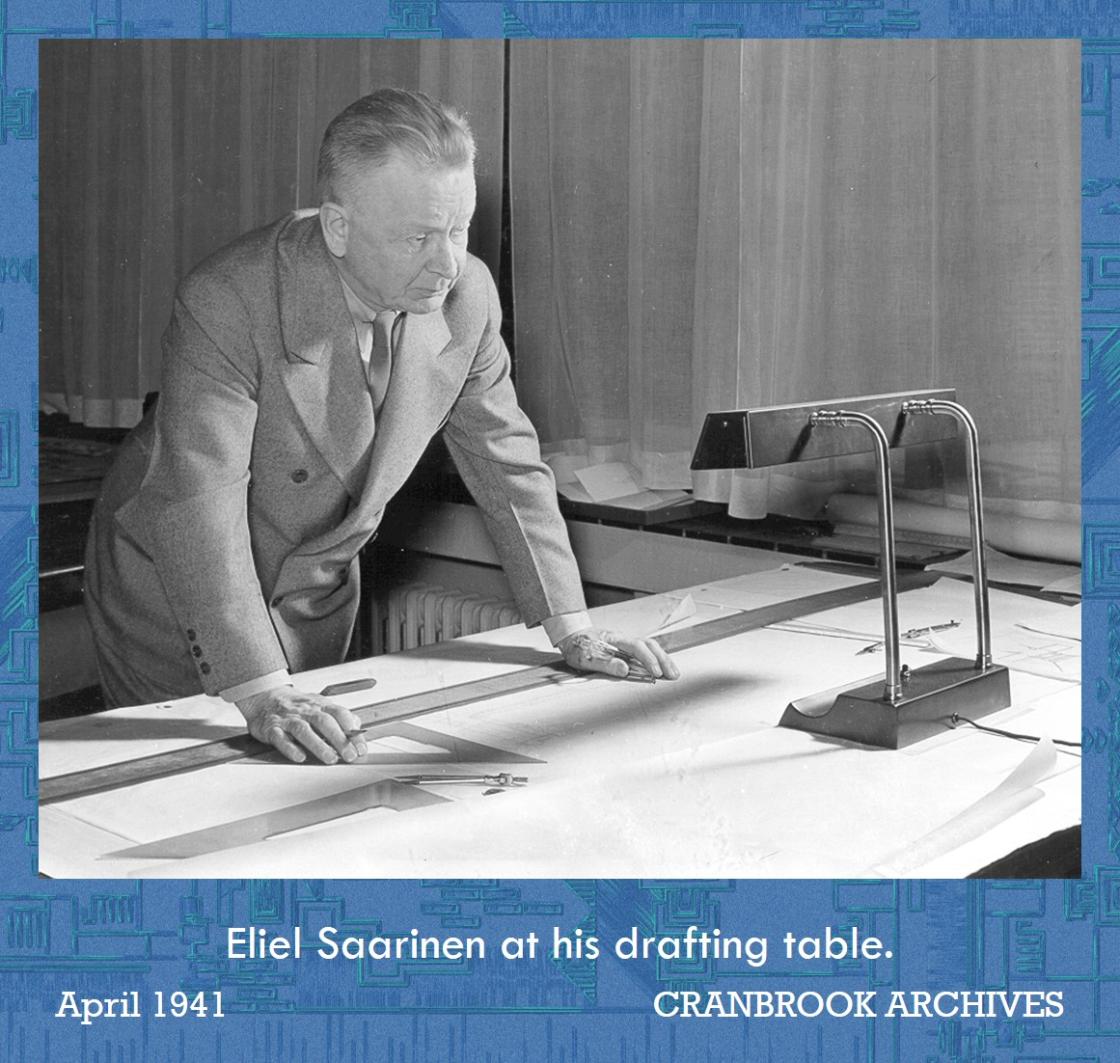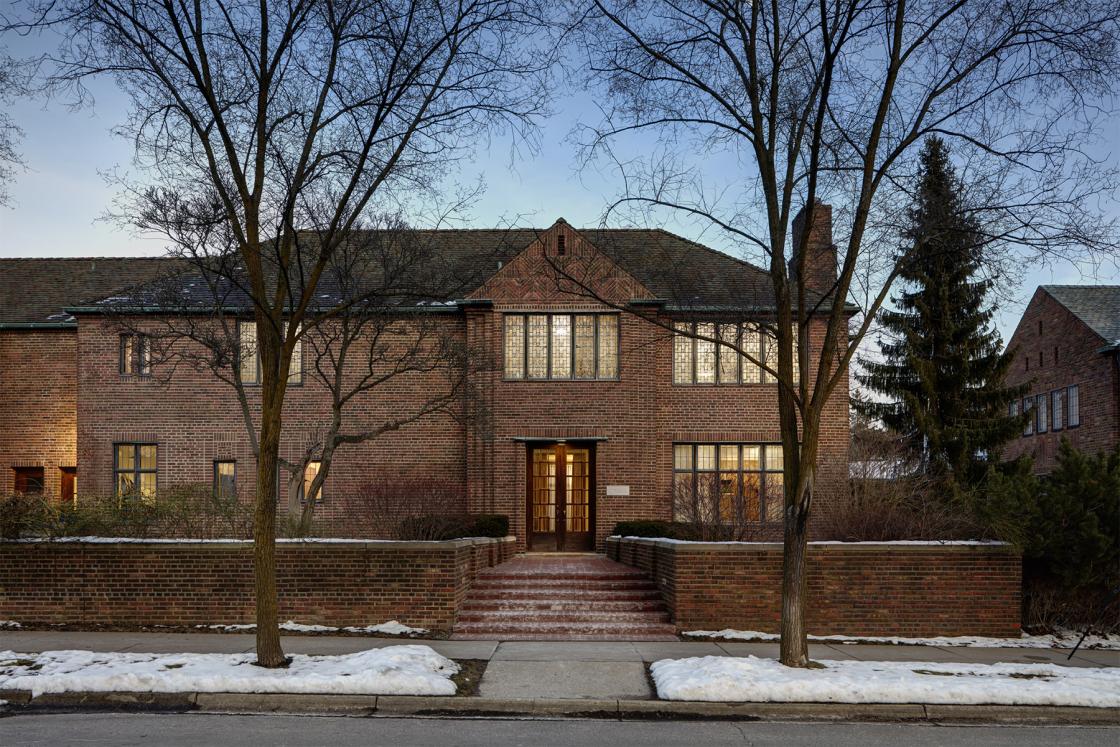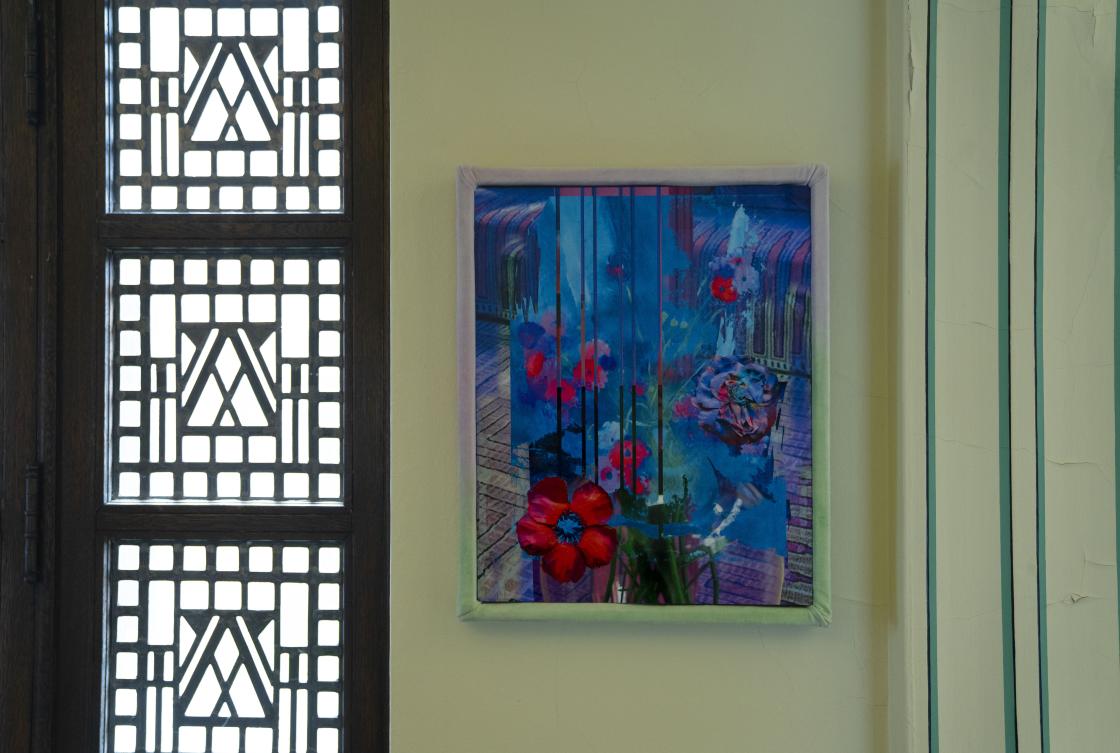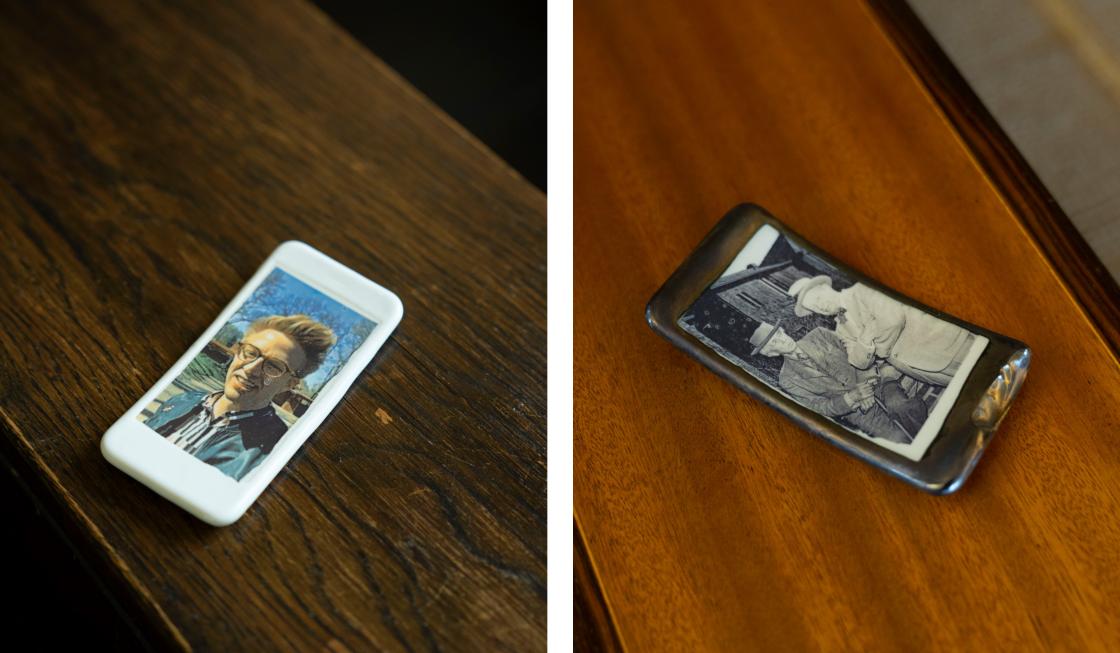SAARINEN HOUSE
SAARINEN HOUSE FIRST FLOOR
HOME OF ELIEL AND LOJA SAARINEN, 1930-1951
ELIEL SAARINEN, ARCHITECT
1930
With almost every object in the home designed by a member of the Saarinen family, Saarinen House stands as a visionary total work of art built for Cranbrook Academy of Art’s president (a role filled by Eliel Saarinen from 1932 until 1946). With this house, the Finnish immigrants demonstrated their conviction that architecture exists as a cohesive environment from the largest to the smallest scale: the landscape, rugs, curtains, and upholstery designed by Loja Saarinen and her weaving workshop, the architecture and furniture designed by Eliel Saarinen, furniture and housewares by son Eero Saarinen, and color schemes and tableware by daughter Pipsan Saarinen Swanson.
To add to such an intentional and complete interior scheme is a daunting task, and one taken on by Academy artists with great care for Speculative Histories. The work in Saarinen House aims to unpack the perfection seen in the restored house museum, draw attention to changes in lifestyle and in artistic practice at Cranbrook between the 1930s and today.
LIVING ROOM
Above the hand-woven rugs and finely crafted furniture made for this room in the Cranbrook Arts & Crafts Studios around 1930, three current students have displayed their work. Brian Szeto’s painting sits in relationship to the Saarinens’ globe, asking “Why don’t I belong?” in swirling blue and pink resin. Malik John-Marc Purvis draws our attention to the fading of the jute cloth wall covering behind Helene Schjerfbeck’s framed drawing. His frame calls out this sun damage, and serves as a “response to the mark left of another artist’s artwork.” In place of a portrait of Loja Saarinen, Ryan T. Genena’s depiction of Africa in black mirror shards ties together the artist’s North African ancestry with his passion for hip hop and is commentary on European colonization of the continent.
Ryan T. Genena
Jaded
Ryan T. Genena, 4D Design 2022
Glass, fiberboard
25 x 32 inches
2021
BOOK ROOM
With two comfortable, overstuffed chairs, the Book Room provided a place for the Saarinens to retire in the afternoons. Loja Saarinen displayed the family’s collection of contemporary art along the window ledge. Cooper Siegel riffed on the combed white glaze of the Saarinen’s Atelier Primavera vase with his own slightly slumped iteration, constructed of rings of glazed and unglazed clay resting on a kiln brick. Nearby, Kelly Kroener quilted a meadow for Viktor Schreckengost’s Young Pegasus.
We know the Saarinens’ grandchildren played in this room after school, and Annie Meyer has tapped into this idea of play for her speculative game Notguys 17-21. Meyer is interested in non-binary objecthood, and how “concepts of fluidity become more accessible through modes of interaction, intimacy, and imagination.” Along the bookshelves, McKenna Quandt has slipped in a new title concerning her home state but found locally in Detroit: A Cook’s Tour of Iowa (1988). The serendipity of finding the book among the Saarinen’s tooled leather tomes matches Quandt’s unexpected find of her grandfather’s photograph inside the cookbook.
Cooper Siegel
Cooper Siegel, Ceramics 2022
Ceramic, glaze, brick
9 x 6 x 14 inches
2021
Shown with:
Primavera Vase
L’ Atelier Primavera d’Art du Printemps
Attributed to Céramiques d’Art de Bordeaux (C.A.B.)
Glazed ceramic
17½ x 5½ inches
circa 1930-1939
Gift of Jan and Bob Swanson, Cultural Properties Collection, Saarinen House
DINING ROOM AND PANTRY
Atop the glowing hare holly and ebony veneer of the dining room table, Architecture Artist-in-Residence and Interim Dean Gretchen Wilkins placed a large gold globe. With her double of the globe in the Living Room, Wilkins writes that hers is “a globe produced for Saarinen House, by the golden, woven stuff of Saarinen House.” In two of the red niches around the room, Ian Torres McLaughlin has stacked found objects with a variety of manufactured goods to create a plural commentary on glut, climate change, and food insecurity. Underneath the table between chair legs lie two wood-framed mirrors by Forrest Hudes intended to invite reflection on the craft history present in Saarinen House. They also allow unexpected views of the construction details of the furniture above.
Atop the battleship linoleum of the pantry, Sculpture Artist-in-Residence Rebecca Ripple placed her text-based work You are…, constructed of a sentence written five times in interlocking aluminum wire. On the countertop sits Elysia Vandenbussche’s architectural meditation on the unseen labor of the house, whether Loja Saarinen’s efforts to promote her family or the housekeeper Anna Danielson’s efforts to maintain the daily rituals of life here.
COURTYARD
At the center of the dramatic octagonal paving pattern of the Saarinen House courtyard stands Kivi’s Muse by Finnish sculptor Wäinö Aaltonen. Dessislava Terzieva has wrapped the muse in the manner of the site-specific environmental installations and building wraps of Christo and Jeanne-Claude but using recycled thrift store clothing. Masking the details of the sculpture and its base, her work abstracts this centerpiece into something new.
STUDIO ALCOVE
In this elegant room, which Loja Saarinen called her “cosy corner,” Gloria Wen responded to the childhood dolls of Eero Saarinen with two figures of her own. Constructed of coal and sitting on a fire-like wool hooked rug, these two new dolls hold conversation across the room to their predecessors. Martha Mysko, Painting Artist-in-Residence, also engaged in a conversation across time: her sublimation dye print uses a combination of digital and physical collage referencing former Academy painting instructor Wallace Mitchell’s nearby work. Manipulating the color and saturation levels toward a high-contrast, distinctly digital palette, the piece is framed in soft velvet as a nod to the Rya rugs and pillows of the space. Willie Wayne Smith, Painting Artist-in-Residence, installed his plaster bust Helen in place of Carl Milles’ Head of Dancing Girl (1917). Helen is covered in script and loose spots of paint, as if her blank surface were the page of a coloring book.
Gloria Wen

Gloria Wen (Kexin Wen), Metalsmithing 2022
Paper, coal, brass, wool
10 x 10 x 12 inches each
2021
Shown with:
"Lenci" Girl Doll
Elena and Enrico Scavini
Pressed felt body with painted features
17 inches high
Circa 1920
Gift of Ronald Saarinen Swanson, Collection Cranbrook Art Museum
"Käthe Kruse Doll One" Boy Doll
Käthe Kruse
Molded muslin body with painted features
16¾ inches high
Circa 1910-1920
Gift of Ronald Saarinen Swanson, Collection Cranbrook Art Museum
Martha Mysko
Martha Mysko, Painting Artist-in-Residence
Sublimation dye print on aluminum with dyed velvet frame
18 x 22 inches
2021
Shown with:
Still Life with Flowers
Wallace MacMahon Mitchell, Painting 1935, CAA Drawing/Painting Instructor 1936-1954, CAA Secretary and Registrar 1944-1963, CAA Galleries Director 1955-1970, CAA President 1970-1977
Oil on board
30 x 24 inches
1938
Gift of Peggy deSalle, Collection Cranbrook Art Museum
STUDIO
Within the large studio space, Dessislava Terzieva installed three babushkas: grandmothers rising on broomsticks from concrete-filled Bulgarian cheese tins with kerchief-donned security camera heads. In place of a historic Finnish Rya rug Iris Eichenberg, Metalsmithing Artist-in-Residence, has hung a hooked rug inspired by the landscape of her native Germany. The piece is made from wool donated to the artist by a former Cranbrook weaver who was here in the 1960s and 1970s, reflecting the color palette of that period. Eichenberg brings to life skeins of yarn that sat unused at the Academy for decades.
Zahra Almajidi followed the contours of water stains on three upholstered Eero Saarinen-designed chairs with pins, pearls, and beads to highlight these imperfections within the idealized interior design. On the J. Robert F. Swanson-designed piano, Claire Thibodeau added her black, white, and green vase. It captures the intricate nature of the garden and the ethereal aspect of blooming flowers, while the making process—some eight different firings as the artist attempted to revise the work—results in a layered, if extremely fragile, object.
Throughout the house, Elisabeth Q. Diamond added ceramic iPhones with screens depicting scenes from the distant past (a youthful Eliel Saarinen in Finland), the Saarinens’ present (a visit from Frank Lloyd Wright in 1945), and today (a Facebook Live tour from curator Kevin Adkisson). The phone with young Saarinen rests on the telephone table designed for the architect by his son, Eero. Atop Eliel’s desk, Doug Jones engaged with the existing display of the architect’s tea urn, reproduction drawings, and period drafting tools by slipping in new elements. A pointillist depiction of a swan with hidden and obscured text refers to both Finnish fairy tales and the swans of Kingswood Lake. Bookmarks from a recent University of Michigan Library project by the artist sit inside and aside Penguin Classics copy of W. E. B. Du Bois’ The Souls of Black Folk (written around the same time as George Booth’s book, The Pleasures of Planting).
Doug Jones

Doug Jones, Print Media 2022
Inkjet print on cotton (Swan print), acrylic on cotton and aluminum (University of Michigan Library Connect the Dots PIXEL Project bookmarks), copy of The Souls of Black Folk (cover art by Kadir Nelson), found objects
Dimensions variable
2019-2021
PHOTO CREDITS
Saarinen House exterior photograph by James Haefner, 2017. Courtesy Cranbrook Center for Collections and Research.
Color photography by Eric Perry, Courtesy Cranbrook Center for Collections and Research.
Historic photographs Cranbrook Archives, Cranbrook Center for Collections and Research.









